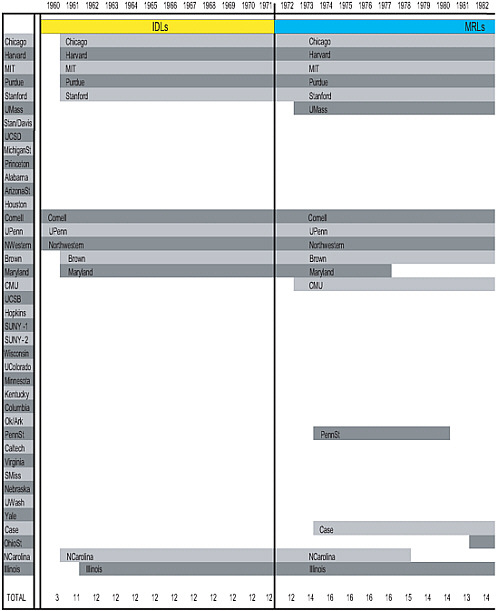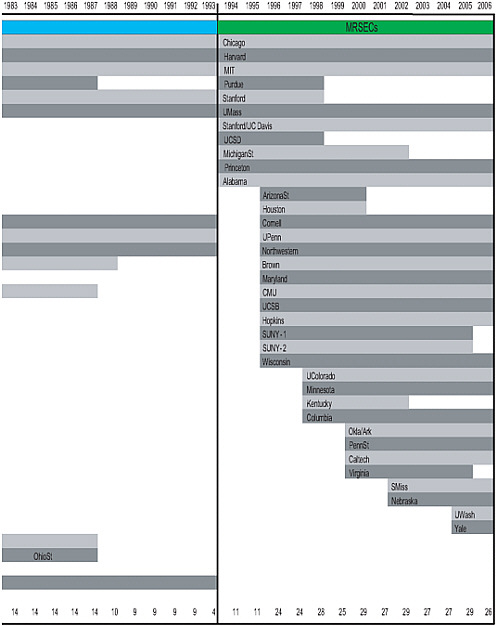2
The Overall Context of the Materials Research Science and Engineering Centers Program
The very complexity of material interactions means that much of the research tends to require extensive experimental trial and error—that is, an Edisonian approach that takes into account the latest results from theoretical analysis and computational modeling. This approach has no guarantee of success, it could require many years, and as in most scientific endeavors, most trials do fail. The benefit of broad-based, long-term efforts across many subfields of materials science is the only way to ensure a healthy, continuous rate of scientific accomplishment. This model is one that has traditionally been supported by the federal government to complement science in general, including the materials science research conducted in academic venues.
The need for brute-force trial-and-error investigations is partially mitigated by the availability of sophisticated analytical instruments. These instruments often allow researchers to obtain profound insights because such tools shed light on the underlying physical principles that govern phenomena; other tools allow researchers the ability to precisely synthesize or construct systems of interest. In order to pool resources and optimize the utilization of these complex and often quite expensive instruments, the tools are frequently collected in a central facility that provides expert staff, maintenance, and training. As a result, long-term financial-support mechanisms are needed to cover not only the initial capital investment (often millions of dollars) but also the ongoing resources needed to enable them to operate to their full capacity over the long term. Thus, the two main ingredients for a success-
ful materials research enterprise are, first, patient, long-term support and, second, a large array of expensive analytical, synthetic, and processing equipment.1
Both of these requirements can only be met by long-term, patient funding that is sufficiently centralized to support a full suite of the most advanced analytical and synthetic instruments. Patient research support, combined with major centralized instrumentation, was the formula for the original Materials Research Laboratory (MRL) program that was the precursor of the current Materials Research Science and Engineering Centers (MRSECs). In fact, the 1999 National Research Council report Condensed Matter and Materials Physics: Basic Research for Tomorrow’s Technology stated: “New facilities and instrumentation create new opportunities in condensed-matter and materials physics, and continued support for facilities and for broad access to them must be emphasized.”2
The current guidelines for competition for MRSEC funding have had two effects.3 The size of the average MRSEC award has shrunk, and the funding has been divided into smaller increments that are too small to adequately support the needed analytical and synthetic centralized facilities. As the infrastructure of instrumentation and facilities is subsequently eroded, the scientific benefits of those centers are thereby diminished. The second penalty is that the constant competition for and turnover of the smaller MRSECs prevents the long-range risk taking that is part of the nature of successful materials research. As noted in Midsize Facilities: The Infrastructure for Materials Research:
The committee recognizes a … need for midsize facilities that have … sufficient size and complexity, either in instrumentation or in the supporting technical staffing or even building infrastructure, to require that significant attention and resources be spent on supporting these core activities. The committee terms these core activities “long-term infrastructure” and recognizes that, as required at the larger national facilities, steady funding and stewardship are required to make midsize facilities work more effectively over the long run.4
In this field, some fraction of the funding must be highly stable in order to allow major risk taking. This risk taking would occur most naturally in the context of a center that is large enough to accommodate both near-term efforts and the
long-term programs. The long-term programs would permit an adequate emphasis on broad-based materials exploration and development.
The MRSECs exist in an interesting culture of interdisciplinary and multidisciplinary research, one that has come to characterize much of materials research. It is on this “cutting edge” that MRSEC research is supposed to exist. The direction of research at any institution at a given time is set by factors such as budget, organization, current trends, and perceptions of needs. While this environment can and has led to many amazing breakthroughs, materials research is currently in a time of constrained or decreasing budgets. At the same time, there is an increased concern about how lagging technical leadership retards the economic competitiveness of the U.S. economy. Great opportunity lies at the interdisciplinary frontiers that MRSEC research explores.
SCIENTIFIC CONTEXT
MRSECs are supported by the National Science Foundation (NSF) to undertake materials research of a scope and complexity that would not be feasible under traditional funding of individual research projects. The research focus at an individual MRSEC is divided along the lines of the Interdisciplinary Research Groups (IRGs)—research groups of varying size—which do not necessarily have commonality with one another, even within the same center. This structure is meant to provide a vehicle for achieving the center’s research mission, which follows from NSF’s mission.
Recently, there has been a trend in the materials research community toward addressing “grand challenges” of materials research.5,6 Given the mission and structure of the MRSEC program, the centers are encouraged by NSF to conduct such “transformative” research.
As an exercise, the MRSEC Impact Assessment Committee developed a list of grand challenges for materials research—energy, health care, water purification, information technology, national security, and so on—in addition to “hot” technologies that could result from materials research. This exercise was meant only for instructional purposes since the subject matter is beyond the scope of this study.
The interim report from the Committee on CMMP (Condensed-Matter and Materials Physics) 2010 addresses the question of important challenges in a more unifying way, focusing on what the committee sees as the broadest research issues
of both scientific and technological interest related to materials.7 These include emergent properties and complexity, energy, physics of life, matter far from equilibrium, nanoscale phenomena, and advanced measurement and prediction. Defining the substance of the materials research frontiers is not the subject of the current report, but it is abundantly clear from even this brief initial discussion of grand challenges and hot technologies that there is a huge variety of issues that require research activities based at major centers to be part of the overall approach.
HISTORICAL CONTEXT
The MRSEC program is descended from a long history of federal investment in institutions designed to promote and support materials research as part of the nation’s research enterprise. Because of the important context set by the history of the program (and its evolution), the important predecessors of the MRSEC program are briefly noted here.
History
The MRSEC program is a descendant of the Interdisciplinary Laboratories (IDLs) begun by the Advanced Research Projects Agency (ARPA, later the Defense Advanced Research Projects Agency [DARPA]) under the Department of Defense (DOD) in 1960 (see Figure 2.1 for a history of the program). The IDL program was intended to support interdisciplinary research in materials science, mainly for application to military uses. Although obvious changes and transitions have been made in U.S. materials science programs since then, it is evident that the MRSEC program’s current ambitions do reflect its origins.
The United States began its formal investment in materials science with the overarching National Materials Program, generated by President Dwight Eisenhower through the White House Office of Science and Technology and the Science Advisory Committee in 1958-1959. Partly because of its unique ability to manage 5-year grants for research (lengthier than others), DOD took on oversight of this new initiative in 1959. The program was assigned internally to ARPA, which named the funding program and its new facilities the Interdisciplinary Laboratories. The work statement from the original ARPA IDL contracts stated:
The Contractor shall establish an interdisciplinary research program and shall furnish the necessary personnel and facilities for the conduct of research in the science of materials with the objective of furthering the understanding of the factors which
influence the properties of materials and the fundamental relationships which exist between composition and structure and the behavior of materials.8
It is important to note that in this early era of materials research, few universities contained academic departments of a sufficiently broad nature to be named “materials science” departments (see Table 2.1).9
The first three IDLs (at Cornell University, the University of Pennsylvania, and Northwestern University) were established after a competition by ARPA. The original three were followed a few years later by additional ARPA contracts, three from the Atomic Energy Commission (AEC; later incorporated in part into the Department of Energy), at the University of California at Berkeley, the University of Illinois at Urbana-Champaign, Iowa State University, and two from NASA.
At the peak of the IDL funding in 1969, these laboratories supported 600 faculty members and 2,385 graduate students and produced 360 Ph.D.s. The research efforts of all those involved in the IDLs were grouped into 134 “work units,” separately characterized by particular research thrusts. These work units, however, lacked a focused team approach, which would later be fostered by the MRL program, upon transfer of the IDL program to NSF.
The IDL program garnered much success, but during the late 1960s the DOD began to reevaluate its role in basic, “non-mission-oriented” research at universities, and after a thorough program review in 1971, the IDL program was transferred to NSF and renamed the Materials Research Laboratory (MRL) program in 1972 (see Table 2.2). At the time, it was perceived that NSF was the chief option for the transferring of the IDLs from DOD. This move was mandated in FY 1968 by the Mansfield Amendment to a DOD spending bill that forced DOD to divest itself of research not directly related to its mission.
Once transferred to NSF, MRL grants became block funding grants rather than a group of principal-investigator (PI) awards operating under an umbrella award, as was true under the IDL program. By encouraging actual team collaboration between faculty in neighboring departments, this change enabled a more collaborative team approach than was possible under the DOD IDL program.
However, the transition was not without its own organizational challenges and disruptions. The NSF responded to the challenges with the creation of the Division of Materials Research (DMR), into which were integrated some of the more traditional materials programs in areas of physics and chemistry.
Focused research in areas of particular complexity that required a team approach of several scientists in different disciplines became more and more common
TABLE 2.1 Trends in Titles of Materials Research Academic Departments at U.S. Universities, 1964-1985
|
|
Number of Departments, by Year |
||
|
Department Title |
1964a |
1970b |
1985b |
|
Minerals and Mining |
9 |
7 |
5 |
|
Metallurgy |
31 |
21 |
17 |
|
Materials |
11 |
29 |
51 |
|
Other |
18 |
21 |
17 |
|
Total |
69 |
78 |
90 |
|
aCompiled from 1964-1970 ASM Metallurgy/Materials Education Yearbook, ed., J.P. Nielsen (American Society for Metals, Metals Park, Ohio). bCompiled from 1985 ASM Metallurgy/Materials Education Yearbook, ed., K. Mukherjee (American Society for Metals, Metals Park, Ohio). |
|||
in the 1970s, owing to the new culture engendered by the MRL program. Funding for these “seed” groups began to compete with other programs for funding. Until 1985, these groups could receive only 3-year contracts from NSF, after a lengthy evaluation process. To provide materials departments with fleeter response to rapidly developing opportunities and developments within thrust groups, the NSF added another program, the Materials Research Groups (MRGs). This program
TABLE 2.2 Year of Establishment and Termination of Interdisciplinary Laboratories (IDLs) and Materials Research Laboratories (MRLs)
primarily targeted funding universities that did not have an MRL; however, some MRLs also received MRG funding. Table 2.2 lists the establishment and termination dates of IDLs and MRLs at institutions between 1960 and 1987.
Political trends in the late 1980s and early 1990s moved toward better maneuvering the nation’s science investment to impact the economy through technological progress and educational outreach. For instance, George A. Keyworth II, President Ronald Reagan’s Science Advisor and director of the Office of Science and Technology Policy, referred to the Engineering Research Centers organized by the NSF as “the single most important thing that we’ve done as an Administration in increasing the efficiency and effectiveness of federal R&D dollars.”10
In 1992, a commission of the National Science Board (NSB) wrote a letter report in which it stated that research in the industrial sector was becoming more sharply focused on market-related issues, with fewer companies supporting long-term research.11 The report recommended that the NSB and NSF should encourage interdisciplinary work and cooperation among sectors, and that NSF should encourage further development of joint science, engineering, and management education programs.
In response to these pressures, NSF reorganized its interdisciplinary MRL and MRG programs into the current MRSEC program. In the shift, the program began to focus on several aspects that its predecessors did not.
MITRE Report
As one component of adjusting its management style to the newly acquired materials research laboratories, in 1976 NSF asked the MITRE Corporation to conduct a study to:
-
Analyze the effectiveness of Materials Research Laboratory (MRL)-type funding as a mechanism for the support of basic research in the materials science area;
-
Identify the characteristics of MRL-type funding that may be appropriate for research support in other areas of research in science or technology; and
-
Be useful for documenting oversight and program accountability, for planning program improvements, and as a model for evaluating similar federal research programs.
In 1978, MITRE published its report, Evaluative Study of the Materials Research Laboratory Program.12 The report surveyed 16 MRLs, including 3 centers that had phased out or were in the process of doing so, and it constructed a comparison control group from the top 15 universities in project grant funds from DMR. The evaluation also included two Department of Energy (DOE) and two NASA laboratories sponsored under their IDL programs.
The MITRE study had conducted extensive peer review of 690 research papers “selected by statistical sampling techniques from MRLs and project-funded institutions.” Citation analysis was then undertaken on more than 2,000 published papers. Data on other factors, such as equipment inventories, major research achievements, and number of doctoral degrees were also collected. The major research achievements, submitted by the MRLs, were reviewed by a panel of 19 experts.
Most notably, the MITRE study concluded:13
-
Universities with MRLs have a better capability (in terms of faculty and equipment) to perform materials research than non-MRL universities without non-NSF materials science centers. The capability of non-MRL universities with materials science centers with funding from non-NSF sources is much like those with MRLs.
-
About 70 percent of the materials research conducted at the MRLs was “unique” as compared to other research supported by NSF and undertaken at those institutions.
-
There are no significant differences between universities with and without MRLs in concentration of funding, annual rate of turnover in research areas, duration of research areas, and continuity of staffing.
-
The review of research publications does not show a clear-cut dominance of one population over the other being compared. There is no statistically significant difference at the 90 percent confidence level among any of the populations with respect to interdisciplinarity and overall indicators of innovation. In quality of procedures, the NSF core-funded papers rank higher than project-funded ones. In contributions per paper to research or technology, NSF core-funded papers rank lower than project-funded. In the use of essential specialized equipment, excluding computers, core-funded papers rank higher than papers from universities without MRLs but with non-NSF materials science centers, but lower than papers from DOE/IDLs.
-
Citation analysis shows that only NSF/Project-funded papers at MRLs were cited with significantly greater frequency than MRL core-funded papers. The latter were cited with about the same frequency as papers from DOE/IDLs and NSF/ non-MRLs without Materials Science Centers.
-
In major achievements, the MRLs have much more than a proportional share (based on total NSF funding) rated in the top 15 percent. However, the MRLs
-
have slightly less than a proportional share of achievements rated in the top 25 percent.
Overall, the MITRE report found that research conducted by MRLs is not more integrated or interdisciplinary in nature than research conducted by the NSF project grants. However, the report concluded that MRLs were “sole contributors” to specialized areas of research such as high-risk research.
An earlier study conducted by the National Academy of Sciences in 1974-1975, entitled Materials and Man’s Needs,14 analyzed whether the achievements of block funding at materials centers could have been possible had the faculty instead been funded directly. Of particular interest to this committee, the report indicates the following:
-
There is little or no correlation between magnitude of block funding and development of the institution as a “materials school.”
-
There is only modest correlation between the availability of block funding and the existence of specialized laboratory buildings, or central facilities, or their scale.
-
There is no correlation between large block grants and degree of interdisciplinary interaction.
The current report returns to these same questions with some more recent information in Chapter 3.
BUDGET CONTEXT
To fully understand the impact of the MRSEC program, the committee found it necessary to compare the scale of effort undertaken by MRSECs to the broader context of materials research. Levels of investment are one metric for doing so.
National Investments
The U.S. federal government has supported basic research in materials since the post-World War II era (see Figure 2.2).
Although the committee could not find distinct data illustrating the history of industrial support for materials research performed in the academic sector, Figure 2.3 shows that for research in general performed by academic institutions, industry’s contribution (now about $2 billion annually) has remained a small fraction of the federal level. Actual industry funding in inflation-adjusted dollars
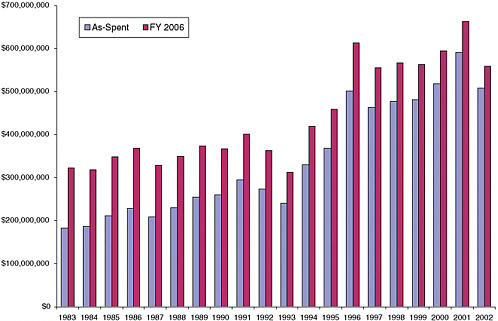
FIGURE 2.2 History of federal support for basic materials research, 1983-2002, excluding facilities construction and operations. In inflation-adjusted dollars, the federal investment in basic materials research has grown by more than 80 percent since 1983 but has remained essentially constant since 1996. This punctuated growth partly reflects the broadening of fields considered to be “materials research.” SOURCE: National Science Foundation, Science and Engineering Indicators 2006.
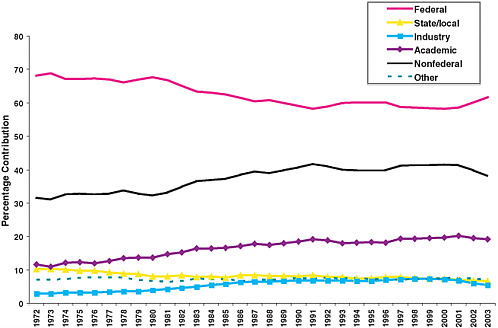
FIGURE 2.3 Sources of academic research and development funding for all research, 1972-2003. The funds provided for academic research and development by the industrial sector grew at a faster rate than funding from any other source during the 1972-2003 period. SOURCE: National Science Foundation, Science and Engineering Indicators 2006.
declined in both 2002 and 2003, the first time that such a decline had occurred in the past three decades. As a result, industry provided only 5% of academic research and development (R&D) funding in 2003, a substantial decline from its peak of 7% in 1999. Industrial support accounts for the smallest share of academic R&D funding, and support of academia has never been a major component of industry-funded R&D. In 1994, industry’s contribution to academic R&D represented 1.5% of its total support of R&D, compared with 1.4% in 1990, 0.9% in 1980, and 0.7% in 1973. Between 1994 and 2004, this share declined from 1.5% to 1.1%.
NSF and the Division of Materials Research
MRSECs were created from the MRL program beginning in 1994, with all MRLs either terminated or converted to MRSECs by the end of 1996. Also by the end of 1996, many new centers were created, resulting in a total of 24 MRSECs. At the same time, the budget for MRL/MRSEC centers increased from approximately $29 million per year (as-spent dollars) in 1993 to $44.28 million per year in 1996. This represented a change of 124 percent in the number of centers but only a 53 percent increase in the total budget (see Figure 2.4). Clearly, MRSECs were “designed” to be smaller than MRLs, and some of the functions of the MRLs were eliminated. In most cases, the MRL-MRSEC transition trimmed staff in shared experimental facilities (SEFs) and decreased the rate and value of equipment purchases for such facilities. Since that time, the MRSEC as-spent budget first slowly increased and then essentially reached a plateau during the years 2003 to 2006 (now at $53.4 million per year).
An interesting comparison is between the “average budget” of an MRL in 1993 and the “average budget” of a MRSEC in 1996 and 2006. To make the comparison realistic, some method of taking inflation into account must be factored in. NSF has used an “OMB [Office of Management and Budget] inflation index”; a second option is the Consumer Price Index (CPI) for all consumers; and finally, there is a “university inflation index.”15 The first two are not identical, but perhaps close enough to follow NSF in the use of the OMB index (for example, from December 1994 to December 2005, the CPI increased by 31.5 percent, while the OMB index increased by 23.9 percent).
The committee estimated the university inflation index by determining the basic cost of a graduate student, taken as tuition, stipend, and overhead incurred
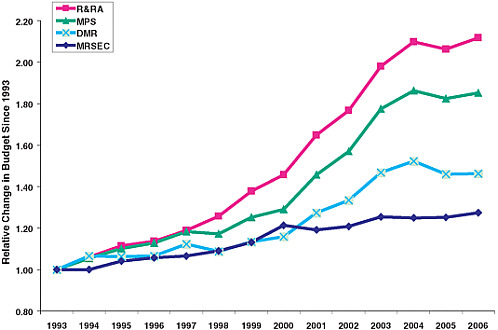
FIGURE 2.4 Cumulative relative change in as-spent budget for different parts of the NSF funding stream: the Materials Research Science and Engineering Centers (MRSEC) program, the Division of Materials Research (DMR), DMR’s parent directorate of Mathematical and Physical Sciences (MPS), and the overall research and related-activities (R&RA) expenditures at NSF. Note that the MRSEC budget line did not formally start until 1994.
on the stipend. Not included in the index are health care, research equipment, and typical materials and supplies. Since “university inflation” as described above is not tracked by any agency, data were obtained from six institutions that have MRSECs. The sample included both private and state universities. For the period December 1994 to December 2005, the lowest growth index value was 52%, with the majority in the range between 70% and 82%. In any case, a safe average of 70% for university inflation is used for this period, acknowledging that the true average rate may be ±10% different from that value. It is also important to note that the rate is not uniform from university to university because each university faces a different set of circumstances.
In 1993, the 10 MRLs had an average budget of $2.9 million (as-spent). Using the OMB index, this adjusts to $3.65 million per year or, using the university inflation index, adjusts to $5.0 million per year. Table 2.3 shows the data for 1993 (MRLs only), 1996 (MRSECs fully established), and 2005.
TABLE 2.3 Annual Budget for an Average MRSEC-Type Center in Different Years Using Different Inflation Indexes
Given the decrease in spending power in the university environment, the average MRSEC can undertake only about 70 percent of the “effort” (as measured by financial investment) that it undertook in 1996, and only 40 percent of the effort that an MRL could undertake in 1993. A second way to express this decreased effort is to look at the total MRSEC budget from 1996 to 2006, which, when adjusted for university inflation, has decreased by 22 percent. Thus, a current MRSEC has fewer financial resources at its command than a previous MRL had. And so, are MRSECs necessarily accomplishing less in comparison? Because the scope of MRSEC activities is so different from that of MRLs and because the research has evolved, it is hard to draw a firm conclusion.
To put this in perspective, first compare these figures to the budgets of NSF and DMR, respectively. According to NSF data, the NSF budget for research and related activities (uncorrected for inflation) increased from $2.046 billion to $4.333 billion from 1993 to 2006 (or an increase of 112 percent, a number that is substantially above university inflation). The situation for DMR is dismal by comparison: from 1993 to 2006, the budget increased from $175.3 million to $242.9 million (or by 38 percent, somewhat more than the OMB inflation index but well below the university index).
Figures 2.5 through 2.7 give the details of the DMR trends. These cost comparisons do not correspond with the number of students reported as supported by NSF for the MRSECs. For example, data supplied by NSF suggest that the number of graduate students and postdoctoral (PD) associates supported in the MRSEC program has increased from 238 + 88 (PD) to 990 + 319 (PD), or an overall increase of 400 percent, although the “start-up time” of matriculating graduate students into the MRSEC program at the time of its inception causes significant distortion (see Figure 2.8). Clearly, the students counted are receiving partial support (much less than half). Clearly, the number of full-time-equivalent (FTE) students and PDs supported by DMR and the MRSEC program must have decreased over the past decade. This is exactly what the committee heard from numerous PIs in its visits to universities around the country. This angst has been met by ingenious ways
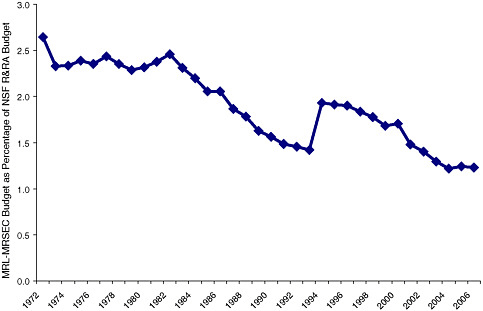
FIGURE 2.5 History of the percentage of National Science Foundation Research and Related Activities (R&RA) budget spent on the Materials Research Laboratory program (up through 1993) and the MRSEC program (starting in 1994), 1973-2006. SOURCE: Division of Materials Research, National Science Foundation.
of bringing multiple sources of funding to bear in order to advance the materials research field, thereby blurring the boundaries further between MRSEC- and non-MRSEC-supported research. These observations beg the question, however, of whether there is any direct linkage between MRSEC impact and partial support of students. The committee did not derive a quantitative metric, but it did come to believe that letting the escalating trend of engaging more and more students with less and less per capita resources constitutes a dilution of impact, not a continuous improvement in efficiency.
The data shown in Figure 2.8 are compiled from MRSEC annual reports. Those reports obviously include people who are partially supported by MRSEC and therefore also by other (unidentified) funds. If one wants to measure how many students the MRSEC influences, the currently reported data are more appropriate. Indeed, the true number is larger than that at institutions where the MRSEC runs extensive facilities, since many students supported on individual NSF grants as well as other types of support (DOE, state, and so on) use those facilities. If, however, one wants to focus on the overall MRSEC research effort, the FTE number would be more appropriate. To enable more consistent reporting over time, it might be
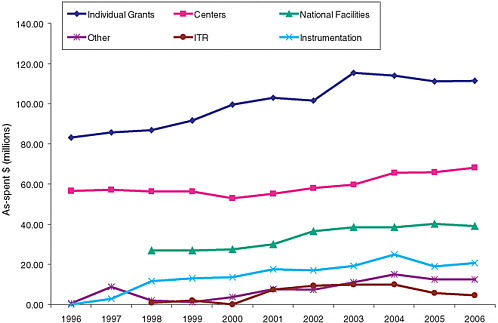
FIGURE 2.6 As-spent dollars for various programs and activities in the NSF’s Division of Materials Research from 1996 to 2006. Centers include Materials Research Science and Engineering Centers, Partnerships for Research and Education in Materials, and some contribution to Nanoscale Science and Engineering Centers and Science and Technology Centers. The individual-investigator programs have increased by 34 percent in this period (but they have been decreasing slightly in the past 3 years), the centers by 20 percent, national user facilities by 45 percent (but the committee has data only for 8 of the 10 years), and instrumentation (Instrumentation for Materials Research program and Major Research Instrumentation, although the latter is non-DMR funds) by 42 percent. The MRSEC part of the centers program has increased in this period by 20.5 percent. ITR, Information Technology Research.
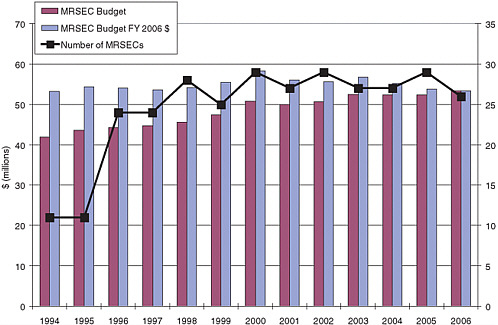
FIGURE 2.7 Annual budget, 1994-2006, for the Materials Research Laboratory/Materials Research Science and Engineering Centers program shown in as-spent dollars and in constant dollars as determined by the Office of Management and Budget inflation index; superposed (black line) is the number of MRSECs operating each year. Note that in 2006, three MRSECs were being phased out and were receiving partial funding in the phase-out period. While this plot suggests that MRSECs have been essentially flat-funded for the past 12 years, the estimated average university inflation index suggests a decline in spending power. SOURCE: Division of Materials Research, National Science Foundation.
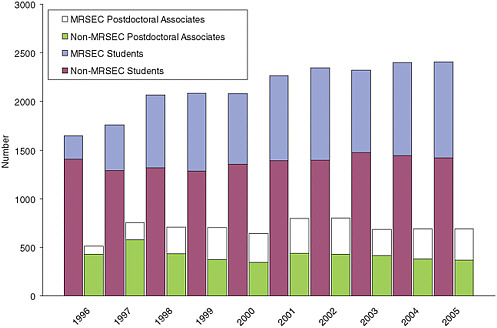
FIGURE 2.8 History of the participation of both students and postdoctoral associates in NSF’s Division of Materials Research (DMR) programs overall and in the Materials Research Science and Engineering Centers (MRSEC) program specifically (as recorded by NSF’s tabulation of annual reports from each MRSEC), 1996-2005. As explained in the text, the expanding number of students participating in MRSECs reflects non-full-time-equivalent reporting. SOURCE: Division of Materials Research, National Science Foundation.
useful for the MRSEC program directors to propose “full-time equivalent” units when centers report levels of participation in the program.
Single investigators at DMR have faced similar conditions. From 1996 to 2005, the median DMR single-investigator grant increased from $83,786 to $112,333 in as-spent dollars, an increase of 34%. During this time, the number of grants increased from 377 to a high of 561 and then decreased to 365 in order to increase the average size of the grants. While the size of the grants has increased in as-spent (34%) and even in OMB-inflated dollars (27%), it has not kept pace with university inflation (an average of 70%) and is much less than the overall increases in the NSF budget in as-spent dollars (more than 100%).
It is certainly possible that the materials community has not been making its case at NSF, and especially at OMB and in Congress. In comparison with other research fields, the community has not been able to articulate adequately the grand visions for the future and the potential benefits to the nation and society in general. Even within the materials field, activities (workshops, reports, and conferences) convened by the Office of Basic Energy Sciences at DOE have been much more successful in making the case for “use-inspired” research within the mission of that agency.
Program Evolution and Turnover
Of the 10 MRLs that existed in 1993, 8 are functioning MRSECs in 2006. These are the MRSECs at Brown University, the University of Chicago, Cornell University, Harvard University, the Massachusetts Institute of Technology, Northwestern University, the University of Massachusetts, and the University of Pennsylvania. Of these, all but the University of Massachusetts MRSECs are rooted in the IDL program (see Table 2.2 and Figure 2.1). Since 1996, when there were 24 MRSECs, 10 have been terminated and 13 started, leading to a total of 26 MRSECs in 2006 (not counting 3 that are receiving phase-out funds). Of the MRSECs added since 1994, a few have grown to be “large MRSECs,” with 3 or more IRGs (Princeton University; University of California, Santa Barbara; and Pennsylvania State University [PSU] in particular, although PSU did host an MRL that was terminated in 1980). Most of the rest are smaller MRSECs with 1 or 2 IRGs. Turnover in the program indicates that the peer-review process managed by NSF does have some impact. The committee was not in a position to second-guess any particular award decisions; numerous committees of visitors to NSF’s Division of Materials Research have affirmed the integrity of the process.
In the last MRSEC competition, only 2 new MRSECs were added to the program out of more than 100 preproposals, with 3 existing centers being phased out. The committee notes that the low success rate represents a substantial amount of
effort. Excessive as this may seem, the 100 preproposals submitted to NSF indicate that the effort is still worthwhile and that MRSEC program is highly sought.
Current MRSEC Budgets
In 2006, the MRSEC budget at NSF was $53.48 million per year. There are 26 MRSECs and 3 in phase-out funding, so the average MRSEC budget is close to $2 million per year (but the actual range is $1.0 million to $3.8 million per year, not counting Partnership for Research and Education in Materials [PREM] funding). As seen in Table 2.4, the MRSEC budget is divided into 6 categories: IRGs (63%), Seeds (10%), Facilities (11%), Educational Outreach (10%), Industrial Outreach (2%), and Administration (4%). As with the individual MRSEC budgets, there is considerable variability from center to center in these categories, especially in the last three (see Figure 2.9). Individual MRSECs also leverage these funds through institutional commitments, user fees in shared experimental facilities, and/or industrial and state support.16
It is interesting that the decrease in support (at the university inflation rate) for both the MRSECs and single investigators has put an even larger strain on maintaining forefront facilities. Since SEFs rely on a large user base for user fees, and since many of the users are supported on single-investigator grants with shrinking materials and supplies budgets, the facilities system is being squeezed from both sides. Neither MRSEC nor single-investigator research in materials can be competitive worldwide (or even carried out) without the capabilities present in SEFs. In fact, this was one of two principal aims of the IDL program when it was first established (the other was to promote interdisciplinary research). Successful industrial collaboration relies, more often than not, on good instrumentation and facilities on the academic side of the collaboration to enable the exploratory research sought by the industrial partner. The importance of shared experimental facilities and the availability of capital and operating funds cannot be overestimated.17
NSF plans for the future of the materials center program must address this issue or the materials program will soon be noncompetitive on the international level. The National Academies report Experiments in International Benchmarking of US Research Fields states that “there continues to be concern among top university researchers that facilities and equipment for materials research in several foreign
|
16 |
The committee heard testimony during its site visits that research groups proposing MRSECs were backed by as high as a 30% cost-share from the host institutions alone. |
|
17 |
See also, National Academy of Sciences, National Academy of Engineering, and Institute of Medicine, Advanced Research Instrumentation and Facilities, Washington, D.C.: The National Academies Press, 2006, especially Chapters 3 and 4. |
TABLE 2.4 Breakdown of Average Annual Budget for a Materials Research Science and Engineering Center in 2006
|
Category |
Average MRSEC Spending per Year (U.S. $) |
|
Interdisciplinary Research Groups |
1,260,000 |
|
Seeds |
200,000 |
|
Facilities |
220,000 |
|
Educational outreach |
200,000 |
|
Industrial outreach |
40,000 |
|
Administration |
80,000 |
|
Total |
2,000,000 |
|
SOURCE: B. Keimer, Max Planck Institute for Solid-State Research, private communication. |
|
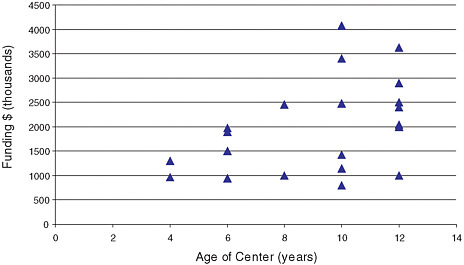
FIGURE 2.9 Materials Research Science and Engineering Center (MRSEC) annual budgets as reported in their FY 2005 annual reports versus the age of the materials center at the host university. Of the 15 centers in the 10- and 12-year bins, 9 centers received funding beginning with the Interdisciplinary Laboratory or Materials Research Laboratory program. SOURCE: Compiled by the committee from collected annual reports (FY 2005) from the MRSECs.
universities now outclass those at most universities in the United States.”18 Indeed, during a site visit, one individual observed that resources for instrumentation and facilities in the United States were so poor that the MRSEC-added SEF funding merely slowed the local rate of decay as compared with other U.S. facilities, thereby maintaining relative leadership.
INTERNATIONAL CONTEXT
Research centers are a common element of national materials research programs in many countries. For instance, the United Kingdom, Germany, Switzerland, France, Japan, and China all have systems of research centers as part of their public investments in materials research. Thus, the U.S. MRSEC program is not globally unique. In this section, the committee briefly examines the international landscape of materials research to put the U.S. MRSECs into a global context.
Other reports have made significant strides in characterizing the U.S. materials research enterprise in comparison with foreign programs. For instance, the National Research Council report Globalization of Materials R&D: Time for a National Strategy19 presents a framework for developing a strategic approach to national research efforts in an increasingly connected world. While this committee examined that report and similar ones, it made no effort to repeat the analysis. Rather, this committee comments here on the role that materials research centers play in several other countries.
The Deutsche Forschungsgemeinschaft (DFG, German Research Foundation) is responsible for the management of a new federal program called the “Excellence Initiative” for strengthening research at German universities. The German federal and state governments have provided a total of €1.9 billion for 5 years to boost research performance at Germany’s top universities; a further 5 years are envisaged. The money will support approximately 30 clusters of excellence (about €6.5 million per year each) and approximately 40 graduate schools (about €1 million per year each) and will fund structural measures to enhance international competitiveness. The first round of evaluations is now finished. A total of 292 draft proposals for graduate schools and centers of excellence were reviewed in different panels. As a result of this first evaluation step, 41 initiatives for clusters of excellence and 38 initiatives for graduate schools were invited to submit full proposals, among these are 3 clusters of excellence and 3 graduate schools in the field of “Condensed Matter Sciences.” After a total of 88 proposals for the three funding lines were evaluated and discussed by international review panels and the Joint Commission of the German Science Council and the DFG, the Excellence Initiative Grants Committee awarded funding to 18 graduate schools, 17 clusters of excellence, and 3 institutional strategies. The decisions were announced in Bonn by the Federal Minister of Education and Research, Dr. Annette Schavan, as well as the Ministers of Science and Research, Professor Peter Frankenberg (Baden-Württemberg), and Professor
Jürgen Zöllner (Rhineland-Palatinate). For this first round, about €175 million have been approved per year to fund initiatives at 22 universities.20
The National Research Council report Midsize Facilities: The Infrastructure for Materials Research made the following observations about activities in Japan and elsewhere in Europe:21
Some important features are revealed by considering how these same issues are approached in other countries. Japan has the extremely impressive National Institute for Materials Science (NIMS) in Tsukuba, with about a thousand researchers and a remarkable array of equipment (e.g., over 35 advanced TEMs, including two high-voltage, high-resolution microscopes that no longer exist in the United States after the decommissioning of the NCEM microscope in 2004). The Japanese facilities, like those in the major national universities, reside largely in the groups of individual investigators rather than being multiuser operations.
In the United Kingdom, excellent facilities are found at the elite institutions (e.g., Oxford and Cambridge Universities). These are continually upgraded (e.g., Oxford already has an aberration-corrected TEM) and are well supported with technical and scientific staff. However, there tend to be fewer users from outside those institutions.
Many of the midsize facilities in France are supported by the Centre National de la Récherche Scientifique (CNRS). Thus, many of the scientists are permanent government employees themselves…. The smaller European countries with on the order of 10 million population each (e.g., Belgium, the Netherlands, Sweden) tend to have a few highly funded, well-supported centers which are national resources and are extensively used by many colleagues on a national and international level. Examples include the high-resolution electron microscope (HREM) laboratory at the Middelheim Campus, University of Antwerp, Belgium; the Dutch National Center for HREM in Delft, Netherlands; the Swedish National Center for HREM at the Lund Institute of Technology; Interuniversity MicroElectronics Center (IMEC) in Leuven, Belgium; and Materials Analysis at Chalmers (MACH) at Chalmers University of Technology, Göteborg, Sweden. The model of these smaller countries is one to note especially. These are stable, well-funded facilities that serve a large number of users. They are successful because of a combination of recognized need, enthusiastic collaboration, and continued oversight from the government and scientific community. It is also undoubtedly advantageous that these countries are geographically small, so that national facilities are never more than a few hours’ drive away.
The 1998 report of the National Research Council’s Committee on Science, Engineering, and Public Policy entitled International Benchmarking of US Materials
|
20 |
For the full list of awards, see the press release at http://www.dfg.de/en/news/press_releases/2006/press_release_2006_54.html (last viewed October 14, 2006). |
|
21 |
National Research Council, Midsize Facilities: The Infrastructure for Materials Research, Washington, D.C.: The National Academies Press, 2006, p. 27. |
Science and Engineering Research22 presented an assessment of the U.S. position in materials science and engineering (MSE) research in the near and long term, based on current trends in the United States and abroad. The report concluded that the United States is among the world leaders in all subfields of MSE (as defined in the report). It does warn, however, that the United States should expect an erosion of leadership as Europe and Japan increase their support of MSE. The 2005 report Globalization of Materials R&D23 also shows that while the U.S. share of global R&D has remained steady since the 1990s, its lead in MSE is weakening and being tested by the European and Asian regions.



























